#hyc – Howth is an odd old place, and those of us who live on this rugged peninsula on the north side of Dublin Bay readily accept that view. Peninsular folk anywhere are invariably odd, so that's Proposition One settled immediately. And as for old? Well, in the Irish context, Howth is as old as you can get. So old, in fact, that it's not really Irish at all. The rocks of Howth are around 600 million years old, give or take a few weeks. But the rocks of nearby Ireland are only 300 millions years old. So once you've settled into Howth, you find yourself thinking of Ireland as that dodgy new place somewhere over to the westward, a weird landmass that could disappear as easily and quickly as it arrived.
The only real problem with Howth is the tombolo. That's the strip of sand which connects us to this new place called Ireland. Almost within recorded history, and certainly within folk memory, Howth was an island, and happy with it. But once the sand built up and provided a causeway, we had to accept the new neighbours, and even interact with them. Thus today Howth is administratively part of Fingal, that intriguing area which used to be North County Dublin, but was Fingal long before that, and for a long time too. It's a place of fine farmland and a much indented coastline, with five proper islands including the handsome Lambay and the precipitous Ireland's Eye, and a substantial rock – Rockabill – which is big enough to support a lighthouse, several former keepers' houses, and the world's largest colony of roseate terns.
In all, the coastline of Fingal is about twenty miles in the shortest distance between the Baily headland to the south, and the crowded little port of Balbriggan to the north. But if you measured it in any detail, you might well approach a hundred miles. Off this coast is a sea well filled with fish of all kinds, and though it has tidal currents, they generally aren't too strong for comfort. So it's an ideal place to sail, and a fascinating little cruising venue in its own right.

Seen independently of Dublin Bay, the coast of Fingal can be a fascinating sailing venue in its own right.
The reason it isn't more widely seen as such is the D-word. The elephant in the room. The great heaving mass which is Dublin, right next door. Despite its unique attractions and more interesting sailing waters, the coast of Fingal is invariably perceived as less glamorous than high-powered overcrowded Dublin Bay just round the corner. These days, that's often an advantage. Dublin Bay can take care of the social froth, while the waters of Fingal accommodate their own time-honoured forms of sailing.
But every so often Howth Yacht Club attracts a major international event to the usually quiet waters of Fingal, and this has the welcome effect of making us waken up and see our home port and its waters anew. It also makes us marvel at the underlying levels of voluntary enthusiasm and organisational ability within our club membership, while at the same time reinforcing useful community spirit with the village and the larger neighbourhood of Fingal.
So this past week we've been seeing Howth through the eyes of the sailors of many nations in the BMW J/24 Worlds 2013. They seem to like Howth and Fingal, and Howth certainly likes the J/24 people. You can warm to a class which has the intriguing history of having been conceived 35 years ago in an American garage which just happened to be big enough to accommodate a completely new 24ft one design boat which was so innovative that that it took off worldwide at record speed. But it is still basically such a homely concept that although the J/24 was uber-cool in its most popular days, it was never unpleasantly glitzy, and today it is finding its greatest strengths through owners of all ages who are happy to make the best of hulls which are no longer in the first flush of youth, yet provide great sport without an outlay which might break the bank.

The opening ceremony, with the skippers fronting the platform as Organising Committee Chairman Derek Bothwell outlines the programme Photo: W M Nixon
Nevertheless, when a class has been accepted so enthusiastically that it is arguably the Number One Global Local One Design, staging its World Championship makes ferocious demands on a club. We needn't go into the details, but I do know that in Howth an organising committee headed by former commodore Derek Bothwell (no slouch on the race course himself), has been beavering away for a long time, and as the set date of August 25th 2013 drew nearer, increasing numbers of volunteers were brought on stream and sub committees came into being to deal with matters of which your ordinary sailing Joe knows nothing.
That same ordinary sailing Joe may make smartass comments about it being just another World Championship in a sport which has so many international classes that each year there are something like 143 new world title holders. But that really is what true sailing is all about. Sailing is a vehicle sport, and different vehicles suit different folks. So if a class merits international status, then its World Championship merits the full lineup of umpires and international jurors and the entire paraphernalia of administrators prepared to function in a global setup. It's mind-boggling, yet people are prepared to take it on with enthusiasm, and when you see a championship taking shape on the water, you begin to understand what it's all about.
After all the behind-the-scenes work, it begins to go public, usually with a national open championship, and then with the Worlds proper. This invariably begins with an opening ceremony which is planned to hit the right note of seriousness without becoming too pompous, while at the same time suggesting that sport will be paramount, but everyone might just have a bit of fun along the way.
The layout in the Howth YC marina complex was used to good effect with a top local piper, Ken Sheridan of a distinguished local seafaring family, leading the contending skippers in last Saturday evening, headed by defending champion Mauricio Santa Cruz of Brazil. Say what you like about bagpipes (and most people do), but it's a distinctive instrument, giving out an unmistakable sound which clearly identified the focus of the action, and led straight into speeches of merciful brevity with the actual opening being performed by the Mayor of Fingal, Councillor Kieran Dennison, to the approval of a large and light-hearted crowd on the club balcony.
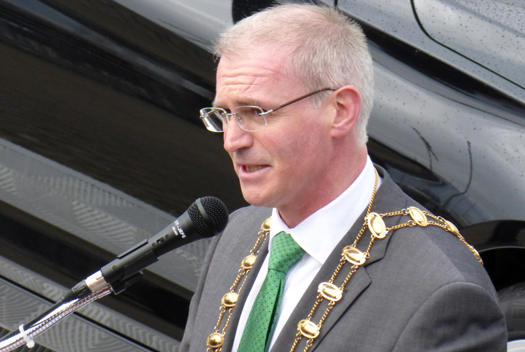
The Mayor of Fingal, Cllr Kieran Dennison, officially opens the championship. Photo: W M Nixon
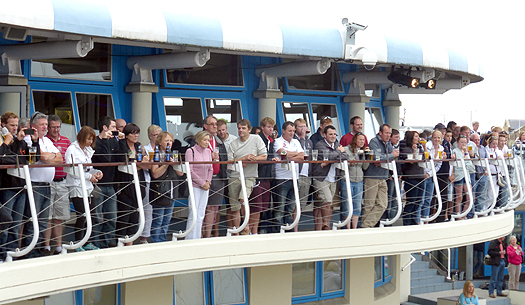
HYC's unique balcony. At times like this, we can only hope the architect has got his calculations right Photo: W M Nixon
As he leads a council which runs Ireland's fastest developing territory, and includes within its ambit such powerful amenities as Dublin Airport and Howth Harbour (not to mention half a dozen of the top golf courses in Ireland), Councillor Dennison would be just the man to be our new Head of State after we declare the new and gloriously independent Republic of Fingal. But that's another day's work. Meanwhile, Principal Race Officer David Lovegrove (another former HYC Commodore) and his team had to put in a practice race next day (Sunday August 25th) which went well in sunshine and a northerly breeze. And as many of the more seasoned campaigners have a superstition that you should never cross the finishing line in the practice race, the popular JP McCaldin of Lough Erne YC was surprised and delighted to find himself atop the winners podium.
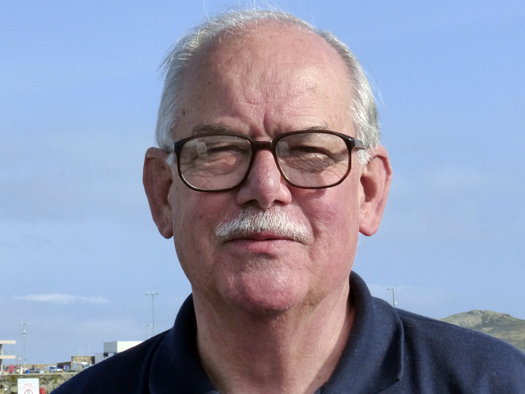
Robin Eagleson from Lough Erne, the amiable President of the J/24 International Association, was persuaded to look appropriately statesmanlike. Photo: W M Nixon
This was a timely reminder that in the tortuous worldwide web of J/24 politics, a leading role is played these days by the global class president, Robin Eagleson of Lough Erne. He's usually such an easygoing and amiable guy that it's sometimes difficult to accept that, in the world of J/24 administration, he's seen as an awesome figure of statesmanlike status who can steer contentious issues to a peaceful and successful conclusion in hot-tempered committee rooms. Somehow next morning I managed to persuade him to look statesmanlike when I was taking his photo while heading towards an appointment with that legend of Howth sailing, Neville Maguire, to go out on his 23ft twin-screw motor cruiser to see a day's racing.

Our skipper for the day, veteran sailing superstar Neville Maguire Photo: W M Nixon
You wouldn't dream of asking Neville's age, but I know his 80th birthday was celebrated quite a few years ago. He started winning the first of many Helmsman's Championships of Ireland shortly after the competition was inaugurated in 1946. He has won major titles in many classes, and an apotheosis of Maguire family sailing achievement came in the last weekend of August 1984, when Neville won the last race of the Irish Sea offshore programme to win the ISORA Championship with his much-loved Club Shamrock Demelza, and on that same day in Kerry, his son Gordon won the recently inaugurated Irish Windsurfing Nationals in the early stages of a hugely successful international sailing career.
The word is good on Gordon, currently the champion offshore skipper in Australia. His successful five year linkup with Stephen Ainsworth and the wonderboat Loki came to its planned conclusion in January of this year, but Gordon is sailing as much as ever – tomorrow he's on the helm on the mini-maxi Caola Isla in the Maxi Worlds in Sardinia, and then in November the new Ichi Ban for top Australian owner Matt Allen is due to be delivered from the builders in Dubai to Sydney, where Gordon and the team will tune her up for the Sydney-Hobart race on December 26th.
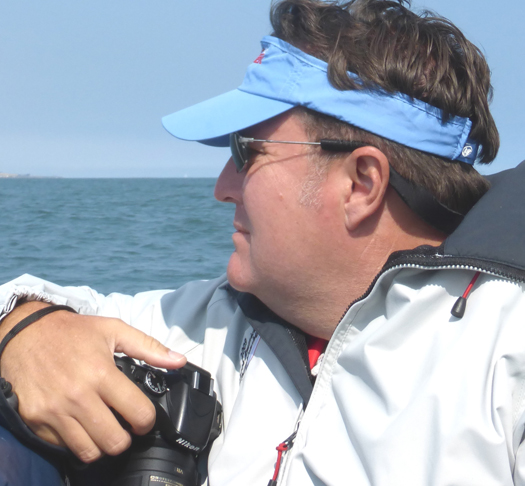
Chris Howell, Executive Director of the International J/24 Association, is also director 0f class associations for the J/22, the J/105, and the new J/70. Photo: W M Nixon
Also on board Neville's neat powerboat was Sean Flood, whose zest for boats and sailing remains undimmed, and fourth member of a congenial ship's company was Chris Howell from America, who was there in his capacity as Executive Director of the International J/24 Association. An interesting man. He graduated in a degree course in managing non-profit-making organisations (I hasten to add that they're planned not to make a profit – we're not talking Ireland these past six years). Clearly, he has found his vocation in running one design boat associations, which is not for the faint-hearted. In addition to the worldwide J/24 Association, he also runs the J/22 Class Association, and in North America the J/105 association. Most recently, he has also been given the key role in the class association for the J/70, which has taken off like a rocket since it made its debut with 46 boats straight out of the wrappers at the first series at Key West in January, and had 90 boats signed up within 24 hours of the announcement for the first North American Championship at Annapolis next month.
But off Howth, Chris was total in his devotion to the J/24, and he gave us a fascinating insight into regulating a class in which reasonably good hulls can be bought for 5000 dollars, but some people will then be prepared to spend much more on their sails than they have initially spent on the boat. Others feel that some restriction on new sails, and particularly on extremely expensive high-tech sails, is the best way to help the class go forward in its role as the boat of choice for impecunious international sailing wannabees, a category of sailor well represented from several countries in the racing at Howth.

The championship is under way. A clean start for the first race of the J/24 Worlds 2013. Photo: W M Nixon
That first day, we'd to wait until the breeze settled in from the northeast, but when it did it was remarkably steady despite being only in the 5 to 7 knot band. The first race was a cracker, and though those of us with gambling instincts were with Flor O'Driscoll as he took a wild flyer out to the right, there was soon no mistaking the better progress being made by the American hotshots out to the left of the beat, though those who overdid the left side were also punished.
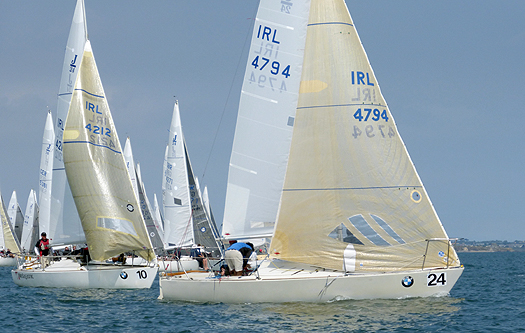
Flor O'Driscoll took a spirited flyer to the right in race one....... Photo: W M Nixon
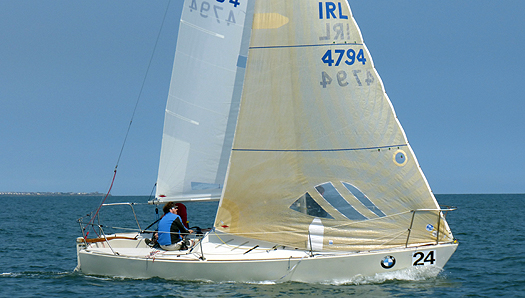
....and looked to be going well in a private breeze........ Photo: W M Nixon

.....but soon reality intervened...... Photo: W M Nixon
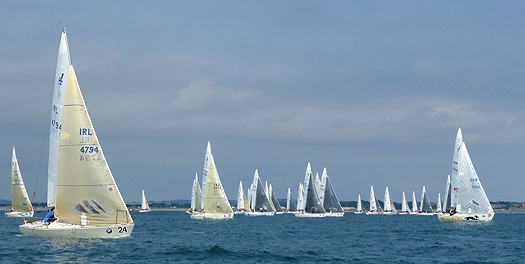
....and the O'Driscoll challenge for the first beat was down the tubes. Photo: W M Nixon
The flood tide was pushing towards north'northwest across the beat, and by the weather mark several had underestimated its effects, but Tony Parker of Annapolis came first to the mark neatly on port after judging the beat and the tide to perfection. But in conditions like that, the long slow run was bound to be painful for the leader. However, Parker hung onto his lead on the second beat, albeit by a much smaller margin from Keith Whittemore from Seattle, and down the run to the finish Parker gave a masterclass in defending his position, such that Whittemore found himself being challenged for the second slot by world title defender Mauricio Santa Cruz. But Whittemore hung in there to make it one two for the US in the sort of conditions they know best (they'd come to Ireland expecting heaps of wind).
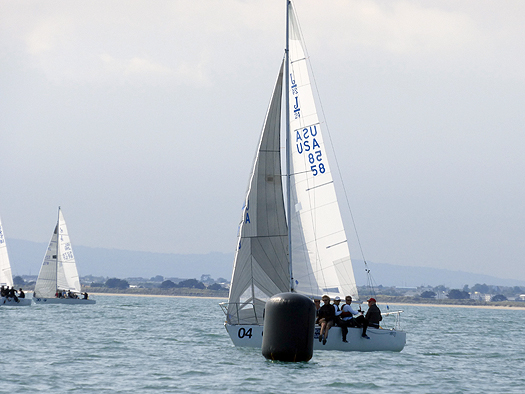
Tony Parker arrives first at the weather mark after a perfect reading of the initial beat Photo: W M Nixon
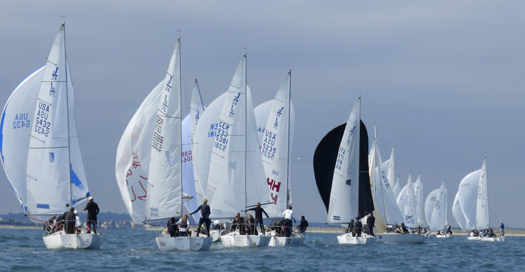
On the downwind leg, the spread of the fleet soon showed the effect of tide across the course Photo: W M Nixon
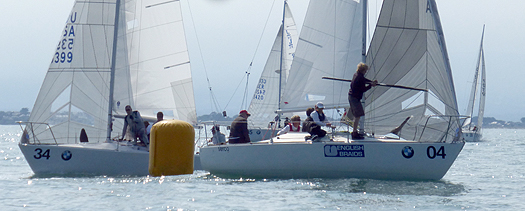
At the weather mark second time, Parker finds himself more closely challenged by Keith Whittemore Photo: W M Nixon

How could this be explained to non-sailing spectators? It's actually an exciting stage of the final run, with Tony Parker (fourth right) keeping control over closest challenger Keith Whittemore (seventh left), while also keeping an eye on third-placed Mauricio Santa Cruz (third right). Photo: W M Nixon
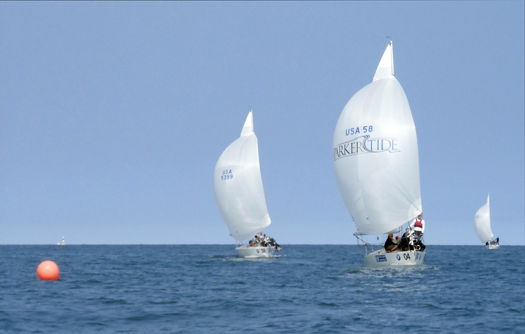
Closing on the finish, Parker has consolidated his lead over Whittemore........ Photo: W M Nixon
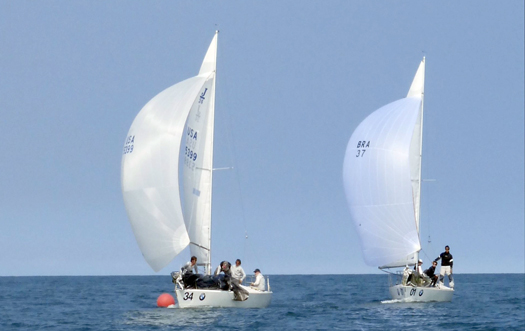
.....who is being challenged in the final stages by defending World Champion Mauricio Santa Cruz of Brazil Photo: W M Nixon
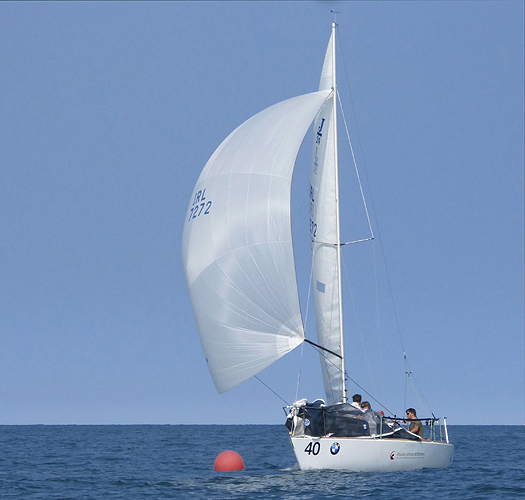
Best of the Irish in the first race was Stefan Hyde, who placed seventh, while the Murphy/Darrer crew in Stouche were 10th to have two Irish boats in the top ten Photo: W M Nixon
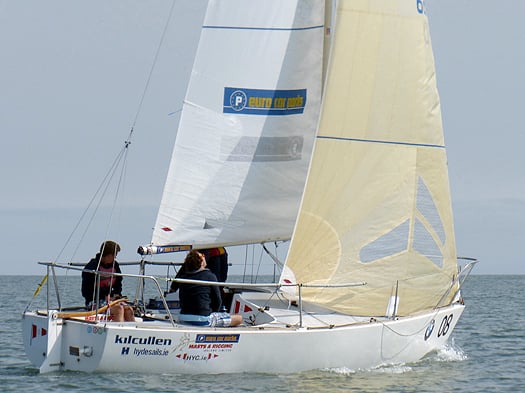
"The Nippers" - Howth YC is fielding an under-25 crew in Kilcullen Photo: W M Nixon
One good race was in the can, the Worlds were properly underway, and at the helm of his RIB the Organising Committee Chairman was one happy budgie. The mood was given an added dimension by an historic Howth 17 gently making her way past the post-race fleet with all sail set to the jackyard tops'l. her 115 years class history putting the supposed maturity of the J/24s into perspective. Then another race was put through after manners were put on everyone with a black flag, and though the next day's racing was to be glassed out, lost completely to calm, the foundations of a championship had been put in place.

Blast from the past – the Howth 17 Pauline (class founded 1898) makes her way past the fleet after the finish Photo: W M Nixon
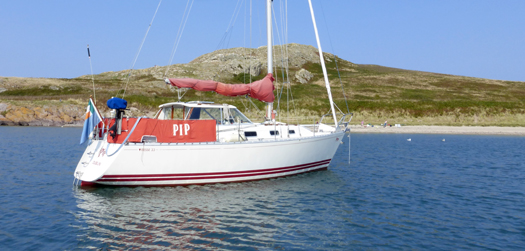
Gerry and Barbara Sargent's Vitesse 33 Pip in the summer anchorage off Ireland's Eye....... Photo: W M Nixon
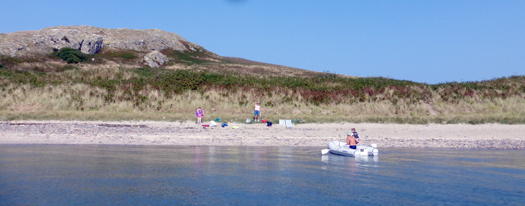
...while on the beach, senior sailors and their grandchildren mess about in boats Photo: W M Nixon
We made our way gently back to Howth's haven under the hills as the afternoon drew on, past a couple of cruisers lying in the anchorage at Ireland's Eye where senior sailors and their grandchildren messed around with boats on the beach, and everything looking very well in a sailing world seen afresh. That evening the party in the club was cheerful, but I'd other duties to perform. It was time for the dog's evening romp on the beach right next to the harbour. It's not every international sailing venue which can provide you with the convenient opportunity to do that. But in Howth, it's an integral part of the package.
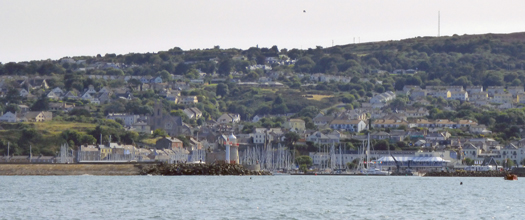
The haven under the hill. Howth is Fingal's main harbour. Photo: W M Nixon































































